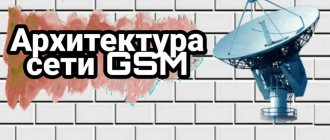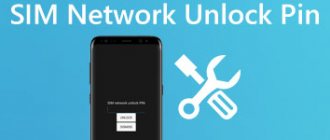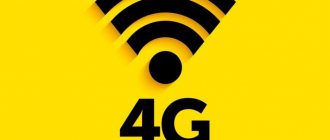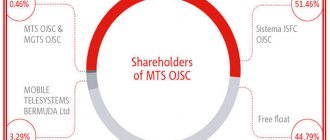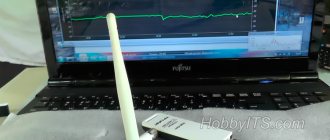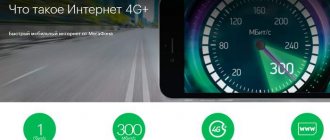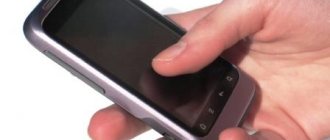1G
The first generation systems (1G, 1981) were analog, implemented on fairly reliable networks, but with a limited ability to offer services to subscribers. In addition, they did not allow roaming between networks, i.e. subscribers with one SIM card could not receive services in the networks of different operators. The first generation systems include: AMPS and NMT, which were later almost completely replaced by the GSM standard. Disadvantages - lack of security (the channel was easy to listen to), difficulties with roaming, low capacity, long range (about 30 km), which in a metropolis is a disadvantage that makes it difficult to reuse frequencies.
Introduction
2G, 3G and 4G stand for “second generation”, “third generation” and “fourth generation” respectively.
The letter G in this case stands for “Generation”, which is translated as “generation”.
All of these are sets of communication standards. Each generation is a set of standards designed for phones and other multimedia devices. They are developing in parallel with these devices.
Rice. No. 1. Devices using 1G, 2G, 3G, 4G and 5G (future)
So when the phone only supported voice communication, the communication standard (at that time 2G) also provided this opportunity for subscribers.
As phones began to support text messaging and then the Internet, standards began to provide these features as well.
Today, these standards work not only for phones, but also for tablets and other devices into which a SIM card can be inserted.
This is in common parlance, but now let’s move on to what are the features and differences of each of these generations.
2G
Second generation mobile communication systems (2G, 1991) are digital. They have brought significant benefits in terms of offering subscribers improved services, capacity and quality. The most common standard of this generation is GSM (originally Groupe Special Mobile, later renamed Global System for Mobile Communications - “global system for mobile communications”). The increased need for wireless Internet access has led to the further development of the 2G system. This is how a system called 2.5G appeared (2000). An example of 2.5G technology is GPRS (General Packet Radio Services) - a standardized packet data transmission technology that allows the use of a mobile terminal device to access the Internet. Later, EDGE (Enhanced Data rates for GSM Evolution) technology was introduced, which made it possible to increase the data transfer rate to hundreds of kilobits per second. Another service introduced in this standard is SMS (short message service).
2G standards have been fundamental to the construction of mobile communication systems for many years. It was GSM that gave a big impetus to the emergence of cellular networks around the world. However, over time, the range of services that 2G standards could offer turned out to be insufficient. In addition, the data transmission technologies used in this standard no longer satisfy network users in terms of speed.
Table of contents:
3G
The factors listed above have led to the emergence of third generation systems (3G, 1999), which allow communication, information exchange and the provision of various entertainment services focused on a wireless terminal device. The development of such services has already begun for 2G systems, but to support these services, the system must have high capacity and radio throughput, as well as compatibility between systems to provide transparent access around the world. An example of a 3G system is UMTS (Universal Mobile Telecommunications System). This standard allows you to provide subscribers with data transfer rates of up to 2 Mbit/s. HSDPA (3.5G) technology gives speeds of up to 14 Mbit/s. Thus, network users can receive a wide range of multimedia services (high-quality video, games, downloading large files). However, even this data transfer rate will satisfy the needs of the network user only to certain limits. In this regard, the development of a fourth generation standard has begun, which will remove the upper limit for a long time.
Thus, in less than 30 years, cellular communication technology has come a long way. Now the subscriber no longer feels geographically tied and can use high-quality telecommunications services wherever he is. There was a change in the basic idea, a shift from voice networks to data networks, and voice became just one of the services of the data network.
In the next five years, the implementation of the concept of the “Internet of Services” can transform the market for M2M (Machine-to-Machine, machine-to-machine communication) services from a secondary one for telecom operators into a key one, just as the market for voice services is now for them.
Main features of a 3G wireless network:
• With 3G we can access many new services, one of them is global roaming. • 3G has a wide-band voice channel, thanks to which civilization came to small villages, because now it was possible to communicate with another person located in another part of the world, and even send him text messages. • 3G gives very clear sound and you can talk without any interference. • 3G has a number of entertainment options: Internet, mobile television, video conferencing, video calls, MMS, online games and much more. • 3G networks (UMTS FDD and TDD, CDMA2000 1x EVDO, CDMA2000 3x, TD-SCDMA, Arib WCDMA, EDGE, IMT-2000 DECT) – cellular networks with data transfer rates from 384 Kb/s to 42 Mb/s. • Wide frequency range and packet switching of 3G devices have made it possible to use applications previously unavailable to users. Some of them: Mobile television. The provider broadcasts the television signal directly to the subscriber's phone (if he is able to receive it). Video. The provider downloads the video to the subscriber's phone. Video conference. Telemedicine. A medical professional monitors the subscriber’s health condition. You can get advice from him, and he can also call an ambulance if necessary. Location of objects. The provider sends information about the weather specifically in the subscriber's region or about traffic jams. You can use the map and find objects of interest to you.
This signal can only be strengthened by installing a 3G repeater.
M2M market today
The M2M market currently refers primarily to the market of wireless mobile devices equipped with SIM cards and designed to transmit telemetry information without human intervention.
According to Berg Insight estimates, in 2014 the number of wireless M2M connections in the world exceeded 200 million. The figure is very modest compared to the total number of connected subscriber devices. The Russian market for wireless M2M connections, according to MTS, contains about 6 million SIM cards, of which more than 60% are installed on vehicles to monitor their location, track fuel consumption, sales, etc.
Business consumers consider their high cost, low connection speed and connection instability to be the key problems hindering the promotion of M2M services on the Russian market. These factors are cited by 59, 45 and 20% of M2M service users, respectively, as determining factors when making a decision to connect to the service (data from J'son & Partners Consulting).
M2M and IoT - what's the difference?
All forecasts about the “explosive” growth in the number of M2M connections are based on the new M2M concept - the Internet of Things (IoT), which is part of the more general concept of the Internet of Services (IoS). The term “M2M device” covers both traditional proprietary telemetry and telecontrol tools (which include the vast majority of M2M devices in use today, including network-dependent wireless ones), as well as network- and application-independent IoT devices. And “Internet of Things” devices are only devices that have the ability, through a free IP connection (at the physical level, usually Wi-Fi), to interact with various telemetry and telecontrol systems implemented as cloud and/or online services. That is, the “Internet of Things” is cloud telemetry and telecontrol.
Cloud systems are capable of providing arbitrarily detailed optimization management of an arbitrarily wide range of control objects, and not only objects as a whole (“smart home”, “smart car”, etc.) and their systems (energy supply, lighting, air conditioning, etc.). etc.), but also individual elements of these systems, down to a separate light bulb in the lighting system. This feature is the reason for the wide spread in forecast estimates of the number of such devices: the number of “smart light bulbs” and other components of controlled objects can actually reach tens and hundreds of billions (in some forecasts, trillions).
2G mobile networks as a worthy replacement for “wires”
Only with the advent of the second generation of cellular networks in the 90s could mobile communications be placed on the same “shelf” with the then traditional cable solutions. Its key competitive advantage over its predecessor was the digital method of transmitting information at speeds of 9.6 - 14.4 Kbps, which not only guaranteed the quality of voice calls, but also allowed the use of the short text messaging service - SMS. It immediately became incredibly popular and remains so today, despite the modern dominance of instant messengers. Contemporary standards are TDMA, CDMA, GSM and PDC.
Requirements of IoT devices for communication networks
To implement the concept of the “Internet of Services”, it is necessary to unify the entire variety of access networks and home/local networks based on the IP protocol stack and the transition of subscribers from using proprietary subscriber devices, sensors and controllers to sensors and actuators made in the ideology of the “Internet of Things” with a free network access to them. For a telecom operator, the main differences between IoT devices and smart subscriber devices are a potentially significantly larger number of the former, orders of magnitude less traffic per device, but at the same time higher requirements for quality characteristics. Such characteristics include: channel availability, signal delay in the channel, level of information security, required radiation power (respectively, the battery life of devices). For telemetry IoT devices, more weight is given to the qualitative (availability, security) rather than the quantitative (capacity) characteristics of the channel. Figure 2 shows the areas of requirements of various services for data networks. Thus, for critical telemetry and telecontrol services, the availability of the communication channel with sensors and actuators should reach 99.999%.
Slow and unreliable packet data transmission on 2.5G
On the threshold of the millennium, existing mobile networks acquired support for data transmission at a speed of 171.2 Kbps, and operators gained the ability to charge not the time of use of services, but the amount of information consumed. The transitional stage of development of cellular communications was qualitatively different from the basic one in the ability to access the Internet with per-megabyte payment. However, surfing the network with its help cannot be called full-fledged, because its standards provided for painfully slow and uncertain transmission of packet data. In many countries of the post-Soviet space, cellular operators have not stepped beyond this stage in the development of mobile communications, so their residents, by and large, cannot fully use the Internet outside of Wi-Fi networks from their smartphones. 2.5G is based on GPRS, EDGE and 1X standards.
LTE
The LTE (Long Term Evolution) system was developed to provide users with access to all kinds of services, as well as to the Internet via the IP protocol. An LTE network consists of many nodes. All network nodes are usually divided into two categories: nodes related to the radio access network (Radio Access) and nodes of the core network (Core Network). The key element that determines the effectiveness of any radio network is the algorithms and mechanisms used to transfer data between the BS and the MS. The following describes the main characteristics of the LTE network related to the radio access network.
According to the requirements for the LTE system, with a cell radius of up to 5 km, all parameters of spectral efficiency, throughput and work with mobile subscribers must be supported. For a cell radius of 5 to 30 km, performance degradation is acceptable.
To ensure bidirectional data transmission between BS and MS, LTE technology supports both frequency duplex (FDD) and time duplex (TDD). For frequency duplex, 15 paired frequency ranges are defined (frequencies from 800 MHz to 3.5 GHz), and for time duplex - eight. In this case, the width of the radio channel can be different. Valid values are: 1.4/3/5/10/15/20 MHz.
LTE uses OFDMA (Orthogonal Frequency Division Multiple Access) in the downlink and SC-FDMA (Single Carrier Frequency Division Multiple Access) in the uplink as multiple access systems. When using OFDMA technology, the entire available spectrum is divided into subcarriers orthogonal to each other. Depending on the channel width used, the total number of subcarriers can be 72, 180, 300, 600, 900 or 1200. Each subcarrier can have its own type of modulation. The following modulations can be used: QPSK, 16QAM, 64QAM.
Multiple access is organized due to the fact that one part of the subcarriers is allocated to one user in the frame, the other part to the second, etc. The LTE standard (namely, 3GPP TS 36.306) defines a total of 15 (document version dated March 27, 2015) categories of mobile devices . The mobile device category specifies the maximum transmission rates in DL and UL. Table 2 lists the bit rates, supported MIMO (Multiple Input Multiple Output) configurations, and modulation types for each category.
Table 2 . Baud rates, supported MIMO configurations and modulation types
| UE category | Downlink | Uplink | ||||
| Maximum number of bits in TTI | Maximum number of bits in a transport block | MIMO | 64QAM support | Maximum number of bits in a transport block | ||
| 0 | 1000 | 1000 | – | – | 1000 | |
| 1 | 10296 | 10296 | – | – | 5160 | |
| 2 | 51024 | 51024 | 2×2 | – | 25456 | |
| 3 | 102048 | 75376 | 2×2 | – | 51024 | |
| 4 | 150752 | 75376 | 2×2 | – | 51024 | |
| 5 | 299552 | 149776 | 2×2, 4×4 | + | 75376 | |
| 6 | 301504 | 149776 (4×4) 75376 (2×2) | 2×2, 4×4 | – | 51024 | |
| 7 | 301504 | 149776 (4×4) 75376 (2×2) | 2×2, 4×4 | – | 102048 | |
| 8 | 2998560 | 299856 | 8×8 | + | 1497760 | |
| 9 | 452256 | 149776 (4×4) 75376 (2×2) | 2×2, 4×4 | – | 51024 | |
| 10 | 452256 | 149776 (4×4) 75376 (2×2) | 2×2, 4×4 | – | 102048 | |
| 11 | 603008 | 149776 (4×4.64QAM)195816 (4×4, 256QAM) 75376 (2×2, 64QAM)97896 (2×2, 256QAM) | 2×2, 4×4 | – | 51024 | |
| 12 | 603008 | 149776 (4×4.64QAM)195816 (4×4, 256QAM) 75376 (2×2, 64QAM)97896 (2×2, 256QAM) | 2×2, 4×4 | – | 102048 | |
| 13 | 391632 | 195816 (4×4) 97896 (2×2) | 2×2, 4×4 | + | 150752 | |
| 14 | 3916560 | 391656 | 8×8 | + | 1497760 | |
| 15 | 749856–798800 | 149776 (4×4.64QAM)195816 (4×4, 256QAM) 75376 (2×2, 64QAM)97896 (2×2, 256QAM) | 2×2, 4×4 | n/a | n/a | |
| 16 | 978960–1051360 | 149776 (4×4.64QAM) 195816 (4×4, 256QAM) 97896 (2×2, 256QAM) | 2×2, 4×4 | n/a | n/a | |
Using the above values, you can roughly calculate the maximum transfer speed. In the downlink channel, the maximum transmission speed values, depending on the category of the mobile station, will be as follows: 10, 50, 100, 150, 300, 300, 300 Mbit/s and 3 Gbit/s. For the uplink the following values are obtained: 5, 25, 50, 50, 75, 50, 100 Mbps and 1.5 Gbps. In Fig. Figure 5 shows the distribution of “down” and “up” speeds by LTE category.
Mobile devices of all categories support channel widths up to 20 MHz (except category 0) and 64QAM modulation (except category 0) in the downstream channel. Category 0 is introduced specifically for MTC (Machine Type Communications). One of the main requirements within MTC is very low power consumption. Hence the strict restrictions on the supported set of functions at the physical level and the buffer size.
The main advantage of OFDMA technology is that it allows you to combat the negative effects caused by multipath propagation when receiving a signal. However, this technology also has some disadvantages. The main ones are that this technology is very sensitive to frequency synchronization. The generated OFDMA signal has a high PAPR (Peak to Average Ratio). This, in turn, affects the fact that the signal amplifier used will operate in nonlinear sections of its characteristics. Therefore, its efficiency will be low, which is quite critical for devices with limited energy reserves (mobile terminals). Because of this, the LTE uplink uses a different multiple access technology, namely SC-FDMA. The difference between SC-FDMA and OFDMA is that SC-FDMA uses additional signal processing to reduce PAPR. SC-FDMA uses the Fourier transform as such additional signal processing. The uplink can use different types of modulation: QPSK, 16QAM, 64QAM.
The LTE standard also supports MIMO transmission technology, which can significantly increase the peak data rate and spectral efficiency value. The essence of MIMO technology is that several antennas are used on each side when transmitting and receiving data. Different antennas can transmit the same data, in which case the reliability of data transmission increases, but not the transmission speed. Also, different antennas can transmit different data streams, thereby increasing the data transfer rate. The maximum LTE technology supports in the downlink channel is 44. This means that four antennas are used on the transmitting and receiving sides. In this case, the data rate can be increased by up to four times (actually slightly less due to the increase in the number of pilot signals).
Using MIMO technology and a channel width of 20 MHz, the maximum data transfer rate can reach 300 Mbit/s in the downstream channel and 170 Mbit/s in the upstream channel.
The LTE requirements specify spectral efficiency values as 5 bps/Hz for the downlink and 2.5 bps/Hz for the uplink (corresponding to data rates of 100 Mbps and 50 Mbps). At the same time, high performance levels must be maintained for mobile users moving at speeds of up to 120 km/h.
LTE Cat.0, LTE Cat.1
One of the main requirements for an M2M/IoT device is low power consumption. To implement this requirement, the LTE standard included requirements for subscriber devices Cat.0, Cat.1 and LTE NB (Narrow Band).
In theory, IoT devices will be able to operate on Cat.1-enabled LTE networks for at least 10 years on a single battery. Many IoT devices will operate without external power supply, that is, the duration of their operation will be determined precisely by energy consumption indicators; mass replacement of batteries is not provided. Energy savings are ensured by support for the Power Saving Mode functionality. A device with this functionality is mainly in sleep mode and turns on only when necessary. Support for Power Saving Mode on the side of LTE network equipment is expected to be standardized in 2021. In November 2015, Ericsson demonstrated the operation of a Cat.1 device based on the Altair FourGee-1160 chipset on the AT&T network using release 16A. This is a very promising direction, especially considering that LTE networks will take over the functions of working with numerous M2M devices, which currently mostly operate via GSM networks.
5G is the near future of mobile communications development
Progress, not surprisingly, does not stand still, so several technologically advanced countries, including the USA and Japan, are actively developing new generation cellular networks.
The first trial launches should begin in the next couple of years, and commercial launches should begin in the 20s. The obvious innovation of the new standards should be another increase in data transfer speed, but other interesting features and capabilities are currently kept secret. The mobile direction of modern consumer electronics is the most relevant today, so the rapid development of cellular networks in the past, present and future is natural.
NB-LTE
NB-LTE - Narrow Band LTE for IoT applications - another subset of the LTE standard, which is planned to be enshrined in 3GPP LTE Rel.13 in early 2021. NB-LTE is intended for a variety of IoT applications, which are characterized by low traffic consumption . NB-LTE is expected to have even more modest resource requirements than LTE Cat.1, Cat.0 and LTE MTC. Expected specification: 180 kHz - frequency band for UL and DL (for LTE MTC - 1 MHz), DL uses 15 kHz frequencies and OFDMA modulation, 3.75 kHz - guard interval, UL uses FDMA or GMSK, as an option there may be SC-FDMA. Expect improved indoor coverage and the ability to serve multiple low-bandwidth devices, especially those that are not too latency-sensitive. Narrowband allows for low-cost chipsets and devices with very low power consumption, which should allow devices to operate for a long time on batteries (such as a large silver-zinc cell or an AAA alkaline cell), up to a year or more. The standard can be implemented on regular LTE networks by allocating multiple resource blocks or by using blocks in the LTE guard band. In principle, isolated deployment of the NB-LTE network in a dedicated portion of the spectrum is also possible. The standard is expected to be widely used, since, unlike various analogues, it is supported by 3GPP. There is, however, a fear that by the time the final version of Rel.13 is released they will not have time to implement NB-LTE, then it will be standardized in Rel.14. But LTE MTC will be included in Rel.13 with almost 100% probability. This standard provides lower power consumption than Cat.0 and better coverage than Cat.0. It loses to NB-LTE, but is almost ready to be included in the standard.
LTE-A (LTE Advanced)
Today, LTE Advanced (LTE-A) is understood as a set of technologies standardized in the 3GPP Rel.10 document and subsequent releases. Key features include frequency aggregation (CA), advanced antenna techniques, enhanced MIMO for increased capacity and relaying. Improvements also include optimization of heterogeneous networks (for increased capacity and improved interference management), SRVCC, eMBMS. Rel.11 also added support for CoMP, eICIC. LTE-A is the main industry trend today, with almost every third LTE network operator in the world investing in testing or deploying support for this technology.
LTE-A is expected to help cope with the strong growth in wireless data traffic and will also help improve average speeds on wireless cellular networks. This also means better coverage, greater stability and faster networks. This means a comprehensive improvement of data network parameters, and not just an increase in data download speed. LTE-A will provide operators with the opportunity to increase the capacity of their networks, improve the quality of user experience, and improve the ability to distribute network resources. To do this, a whole range of different technologies are used, some of which are not new, but have not previously been used in a unified communications system.
LTE-A is expected to deliver data at peak speeds of up to 1 Gbps, compared to 300 Mbps for LTE. Frequency aggregation provides the ability to provide subscribers with higher speeds by allowing data to be downloaded using multiple frequency bands simultaneously. A subscriber device in CA mode receives and combines several signals simultaneously, for example from two carrier frequencies or even from different frequency ranges. You can combine up to five carriers with a width of 20 MHz each, collecting a wide channel for pumping data with a bandwidth of up to 100 MHz. MIMO, as a multiple input/output technology, can increase the overall data rate by simultaneously transmitting a signal while dividing the data stream between two or more antennas. This allows you to increase the spectral efficiency of information transmission. Moreover, it is possible to dynamically create a synthesized directional antenna oriented towards a specific subscriber device.
Relay Nodes are a way to quickly increase network coverage in areas where there are no powerful digital data transmission channels. In this case, the LTE-A radio subsystem itself performs the function of a wireless core network. It is also an opportunity to place low-power BSs at the cell edges to improve coverage and capacity there.
Several reasons why 2G is superior to 1G:
• Weaker radio signals save battery power, so phones can last much longer on charge and have reduced battery size. • Digital voice coding made digital error checking possible, which increased audio quality by increasing dynamic range and reducing noise. • Reducing the power output of phones has helped settle health concerns. • The transition to a digital system has facilitated the introduction of digital data services such as SMS and e-mail • A large-scale drop in fraud levels. With analog systems (1G) it was possible to have more than two clone phones that had the same number (using a clone phone you can take over the subscriber's account). • Increased privacy. It's not often said that digital cellular calls are much more difficult to eavesdrop on using a radio scanner, but this is one of the key advantages of 2G. 2G phones are much more private than 1G phones, which do not have eavesdropping protection.

